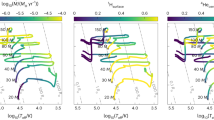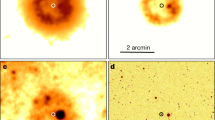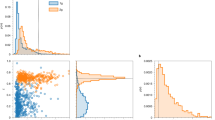Abstract
The X-ray source M33 X-7 in the nearby galaxy Messier 33 is among the most massive X-ray binary stellar systems known, hosting a rapidly spinning, 15.65M⊙ black hole orbiting an underluminous, 70M⊙ main-sequence companion in a slightly eccentric 3.45-day orbit1,2 (M⊙, solar mass). Although post-main-sequence mass transfer explains the masses and tight orbit3, it leaves unexplained the observed X-ray luminosity, the star’s underluminosity, the black hole’s spin and the orbital eccentricity. A common envelope phase1, or rotational mixing4, could explain the orbit, but the former would lead to a merger and the latter to an overluminous companion. A merger would also ensue if mass transfer to the black hole were invoked for its spin-up5. Here we report simulations of evolutionary tracks which reveal that if M33 X-7 started as a primary body of 85M⊙–99M⊙ and a secondary body of 28M⊙–32M⊙, in a 2.8–3.1-d orbit, its observed properties can be consistently explained. In this model, the main-sequence primary transfers part of its envelope to the secondary and loses the rest in a wind; it ends its life as a ∼16M⊙ helium star with an iron–nickel core that collapses to a black hole (with or without an accompanying supernova). The release of binding energy, and possibly collapse asymmetries, ‘kick’ the nascent black hole into an eccentric orbit. Wind accretion explains the X-ray luminosity, and the black-hole spin can be natal.
This is a preview of subscription content, access via your institution
Access options
Subscribe to this journal
Receive 51 print issues and online access
$199.00 per year
only $3.90 per issue
Buy this article
- Purchase on Springer Link
- Instant access to full article PDF
Prices may be subject to local taxes which are calculated during checkout


Similar content being viewed by others
References
Orosz, J. A. et al. A 15.65-solar-mass black hole in an eclipsing binary in the nearby spiral galaxy M 33. Nature 449, 872–875 (2007)
Pietsch, W. et al. M33 X-7: ChASeM33 reveals the first eclipsing black hole X-ray binary. Astrophys. J. 646, 420–428 (2006)
Abubekerov, M. K., Antokhina, E. A., Bogomazov, A. I. & Cherepashchuk, A. M. The mass of the black hole in the X-ray binary M33 X-7 and the evolutionary status of M33 X-7 and IC 10 X-1. Astron. Rep. 53, 232–242 (2009)
de Mink, S. E. et al. Rotational mixing in massive binaries. Detached short-period systems. Astron. Astrophys. 497, 243–253 (2009)
Moreno Méndez, E., Brown, G. E., Lee, C. & Park, I. H. The case for hypercritical accretion in M33 X-7. Astrophys. J. 689, L9–L12 (2008)
Vivian, U. et al. A new distance to M33 using blue supergiants and the FGLR method. Astrophys. J. 704, 1120–1134 (2009)
Verbunt, F. Origin and evolution of X-ray binaries and binary radio pulsars. Annu. Rev. Astron. Astrophys. 31, 93–127 (1993)
Tauris, T. M. & van den Heuvel, E. in Compact Stellar X-Ray Sources (eds Lewin, W. & van der Klis, M.) 623–665 (Cambridge Univ. Press, 2006)
Liu, J., McClintock, J. E., Narayan, R., Davis, S. W. & Orosz, J. A. Erratum: “Precise measurement of the spin parameter of the stellar-mass black hole M33 X-7”. Astrophys. J. 719, L109 (2010)
Hirschi, R., Meynet, G. & Maeder, A. Stellar evolution with rotation. XIII. Predicted GRB rates at various Z. Astron. Astrophys. 443, 581–591 (2005)
Massey, P., Penny, L. R. & Vukovich, J. Orbits of four very massive binaries in the R136 cluster. Astrophys. J. 565, 982–993 (2002)
Bonanos, A. Z. Toward an accurate determination of parameters for very massive stars: the eclipsing binary LMC-SC1–105. Astrophys. J. 691, 407–417 (2009)
van der Hucht, K. A. The VIIth catalogue of galactic Wolf-Rayet stars. N. Astron. Rev. 45, 135–232 (2001)
Rauw, G. et al. WR 20a: a massive cornerstone binary system comprising two extreme early-type stars. Astron. Astrophys. 420, L9–L13 (2004)
Bonanos, A. Z. et al. WR 20a is an eclipsing binary: accurate determination of parameters for an extremely massive Wolf-Rayet system. Astrophys. J. 611, L33–L36 (2004)
Zhang, S. N., Cui, W. & Chen, W. Black hole spin in X-ray binaries: observational consequences. Astrophys. J. 482, L155–L158 (1997)
Li, L., Zimmerman, E. R., Narayan, R. & McClintock, J. E. Multitemperature blackbody spectrum of a thin accretion disk around a Kerr black hole: model computations and comparison with observations. Astrophys. J. Suppl. Ser. 157, 335–370 (2005)
McClintock, J. E. et al. The spin of the near-extreme Kerr black hole GRS 1915+105. Astrophys. J. 652, 518–539 (2006)
Parmar, A. N. et al. BeppoSAX spectroscopy of the luminous X-ray sources in M 33. Astron. Astrophys. 368, 420–430 (2001)
Pietsch, W. et al. The eclipsing massive X-ray binary M 33 X-7: new X-ray observations and optical identification. Astron. Astrophys. 413, 879–887 (2004)
Shporer, A., Hartman, J., Mazeh, T. & Pietsch, W. Photometric analysis of the optical counterpart of the black hole HMXB M 33 X-7. Astron. Astrophys. 462, 1091–1095 (2007)
Orosz, J. A. & Hauschildt, P. H. The use of the NextGen model atmospheres for cool giants in a light curve synthesis code. Astron. Astrophys. 364, 265–281 (2000)
Taam, R. E. & Sandquist, E. L. Common envelope evolution of massive binary stars. Annu. Rev. Astron. Astrophys. 38, 113–141 (2000)
Podsiadlowski, P., Rappaport, S. & Han, Z. On the formation and evolution of black hole binaries. Mon. Not. R. Astron. Soc. 341, 385–404 (2003)
Bondi, H. & Hoyle, F. On the mechanism of accretion by stars. Mon. Not. R. Astron. Soc. 104, 273–282 (1944)
Acknowledgements
We thank N. Ivanova, A. Heger, A. Cantrell and C. Bailyn for discussions during the development of this project.
Author information
Authors and Affiliations
Contributions
V.K. and B.W. designed the study. F.V. led the project, performed the single and binary star evolution calculations, and developed the code to perform the orbital evolution after black-hole formation. V.K. and B.W. collaborated with F.V. in each step of the project. E.G. maintained, updated and extended the stellar evolution code used, and collaborated with F.V. in performing the calculations. W.M.F. determined the correction to the star’s luminosity and surface temperature due to the inclination of the system. T.F. led the theoretical analysis of the black-hole spin. J.A.O. performed the analysis of the observational data on M33 X-7 using the ELC code for the full distance uncertainty. J.L. recalculated the black hole’s spin at different distances. All authors discussed the results and made substantial contributions to the manuscript.
Corresponding author
Ethics declarations
Competing interests
The authors declare no competing financial interests.
Supplementary information
Supplementary Information
This file contains Supplementary Text and Data, acknowledgements, additional references and Supplementary Figures 1-6 with legends. (PDF 449 kb)
PowerPoint slides
Rights and permissions
About this article
Cite this article
Valsecchi, F., Glebbeek, E., Farr, W. et al. Formation of the black-hole binary M33 X-7 through mass exchange in a tight massive system. Nature 468, 77–79 (2010). https://doi.org/10.1038/nature09463
Received:
Accepted:
Published:
Issue Date:
DOI: https://doi.org/10.1038/nature09463
This article is cited by
-
Mass Measurements of Stellar and Intermediate-Mass Black Holes
Space Science Reviews (2014)
Comments
By submitting a comment you agree to abide by our Terms and Community Guidelines. If you find something abusive or that does not comply with our terms or guidelines please flag it as inappropriate.



